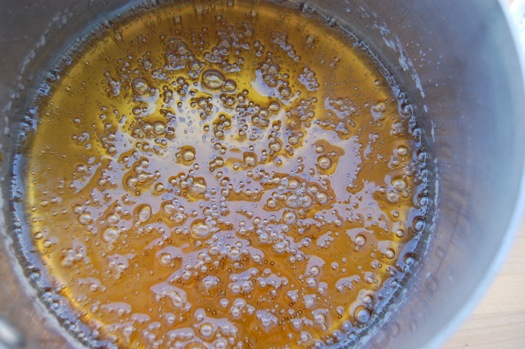Why does caramel burn so easily?

Talk about an inspired question, thanks reader Jo! Most pastry makers know how prone a pan of caramel is to burning if you don’t cool it right away with cold cream or butter, or take it off the heat when it’s still a light amber color. Indeed the whole caramelization process comes on in a rush. You cook and cook and cook this clear syrup until it starts to yellow then it’s dark yellow then brown and whoa nelly! — it’s burnt.
Why does this happen? Partly because molten sugar is a very dense liquid and tends to hold heat. But there’s another more interesting reason which has to do with the caramelization reactions themselves. Most Joe Pastry readers probably already know something about caramelization. It begins to happen to table sugar when it’s combined with water and heated above 300 degrees Fahrenheit. At that point the sucrose starts breaking into its component glucose and fructose molecules, and as the temperature goes up the glucose and fructose molecules themselves start breaking apart.
What do they break into? Pieces. Stuff. No one really knows for sure, but lots and lots of different types of molecules — many of them reactive. These mystery molecules start reacting with each other, as well as with any yet-unbroken glucose and fructose molecules. The result is of course browning and all sorts of different flavors.
And also heat. Because at least some of the reactions taking place in the sugar pan are exothermic, which means that heat is one of their by-products. Which also means that, at least to some extent, a pan of caramel is self-heating. Certainly not to the extent that it can make itself boil once the pan is taken off the heat, but enough so that it takes a curiously long time for it to cool down. Get a little drop on your finger and you’re amazed at how such a tiny amount of amber liquid can stay so infernally hot for so darn long. Its ability to generate at least some of its own heat is part of the reason, and why a caramelization reaction can easily turn into a runaway reaction if you don’t watch the pot carefully.
One could also argue that your blog has gone all exothermic after that last post. I went for a swim earlier today and had that French Polynesian (just guessing 😉 dancing in my head the whole time. I think it’s time for me to revisit pate a choux. As for caramel, I was always under the impression that 186C was the melting point, but I just checked Peter P Greweling’s second edition of “Chocolates & Confections” and the number quoted is 170C and above. And now you tell me it’s 300F (149C). I was always snoozing during Chemistry class so I don’t know for sure, but a little clarification would be much appreciated. Also, more stuff on caramel would be nice – I’m helplessly addicted to the stuff.
I’ll reply on the main page, OB!
– Joe
And here’s a little more just to add to the confusion…
http://www.huffingtonpost.com/2011/07/26/sugar-melting_n_909712.html